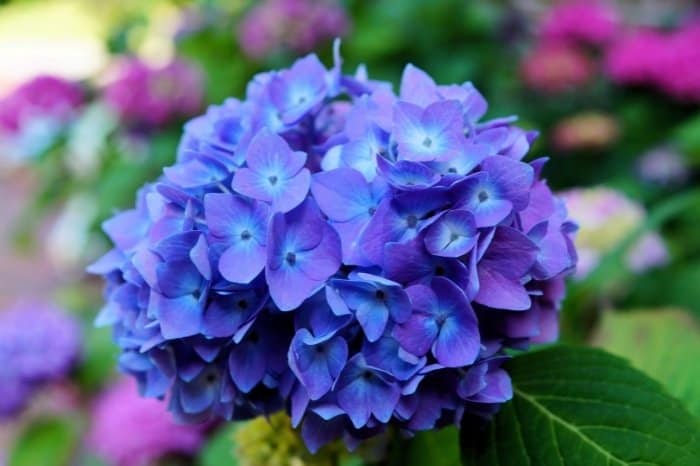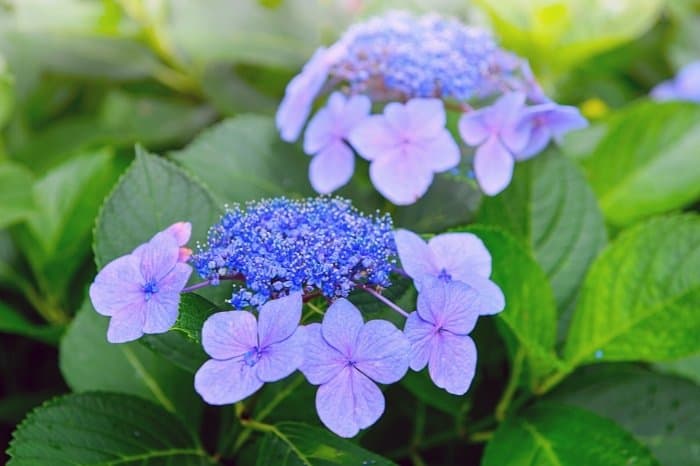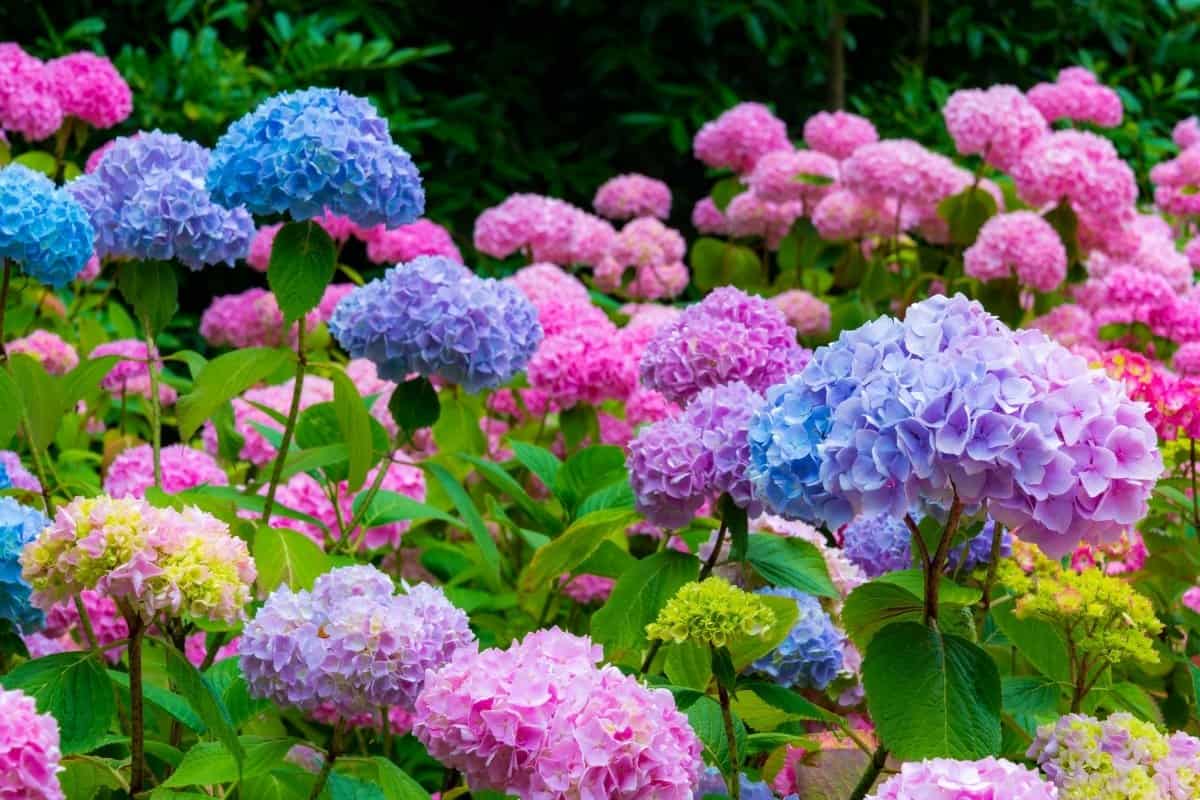Last Updated on February 27, 2023 by Griselda M.
Do hydrangeas come back every year? With the right care, hydrangeas can provide you, your kids, grandkids, and great-grandkids with joy and happiness. These beautiful plants, tended correctly, can survive and thrive for at least 100 years!
Are Hydrangeas Perennials?
Yes. Hydrangeas are perennials – if your hydrangea does not come back after winter, it was not suited to your climate. In zones 4-9 the majority of hydrangeas are natural perennials. In zone 3 select hydrangeas are perennials. In zone 11a, such as one of the places I live, certain hydrangeas are perennial evergreens that flower year-round. A school just down the road from me has a stand of hydrangeas over 100 years old, planted when the school was built. These bloom and stay green year-round.
What Are Hydrangeas?
Hydrangea is a genus of flowering plants native to Asia and the Americas. There are about 75 natural species, and this has given horticulturalists a lot of material to work with! The Hydrangea or Ajisa in Japanese has been cultivated in Japan/Nihon for at least 1300 years. In the western world, it has a shorter history of a few hundred years. During this time, this flower has made an impression!
Hydrangeas thrive in zones 3 to 7 as perennials with flowers starting in spring to last throughout summer into early fall. Hydrangea flowers are helpful as a foundation plant in your landscape.
In higher zones, they are perennial evergreens that flower year-round if planted in a semi-shaded spot that gets enough light but not too much in summer.
Some species are excellent soil pH indicators, being pink at low pH, blue at average pH, and purple at higher pH. There was a time when a steam train for tourism used to come through my town, and we could actually see the change in the color of the hydrangeas close to the railway lines from this due to acid rain in the morning mist causing a change in soil pH. If the steam train was running, the flowers were pink. When it was gone for a few months, the flowers were purple (the soil in my area is naturally moderately alkaline).
There are a wide variety of hydrangeas to choose from, and a local nursery will tend to sell the variety/ies that do/do best in your area.

Are Hydrangeas Annuals or Perennials?
Hydrangeas are perennial shrubs; this means they come back every year. Some people think their hydrangeas are annuals because unscrupulous plant merchants sell plants grown in beautiful greenhouses, covered in flowers, and then are unable to survive in their new environment – this ensures repeat sales, but is a waste of time.
Planting a hydrangea correctly creates a patch of plants that can, with neglect, survive for a hundred years or more – I have seen such patches at abandoned ranch houses, where the fruit trees have all died, but the little patch of hydrangeas at the front door of the collapsed house cheerfully greet the visitors who no longer come.
One of the least frost-resistant hydrangeas is the big leaf hydrangea, which does not do well in zone 5 unless its container grows and is moved inside during winter. The main reason why hydrangeas fail to survive is that the pots dry out too quickly, causing dehydration and later death of the plant.
If you receive your plant as a gift, transfer it immediately to a big pot containing good soil and keep the soil moist with regular watering. Alternatively, if the cultivar is labeled, you can plant it out in the ground if you find that the cultivar will overwinter in your zone. Normally the label will say “Survives outdoors in Zones 4 and above”, or something like that.
Do Hydrangeas Have Thorns?
No. Some have little spiky spines, but these are not thorns unless you have an overly active imagination. The spines can cause minor skin irritation, and I once got a little rash from these when I was pinching hydrangea flowers for a girl one night, and the spread and mischief of the operation resulted in me rubbing my arms against a few stems. The hair-like things can get in the skin ever so slightly and you get this little red rash. Nothing serious. If this worries you wear a long sleeve shirt and gloves.
Are Hortensia Flowers the Same as Hydrangea Flowers?
Yes. Hortensia is another common name for Hydrangeas. To some people it has a nice exotic name, so you may find the occasional person using this name. It is a beautiful name and sounds sort of romantic whereas hydrangea sounds a bit like a pool-cleaning chemical, so I can see how the more romantic amongst us would use this name.
Do Hydrangea Need Full Sun
This depends on which zone you are in. Up to about Zone 6 you should consider planting your hydrangeas in full sun. In zones higher than this you can plant in patches that will get dappled shade in peak summer. From Zone 9 upwards, try to plant them in places where they get full sun in winter, and dappled shade in summer.
Hydrangeas are all about microclimate – you can grow them anywhere really, as long as the microclimate is right. This is the little localized climate that applies to a specific area. In my garden, I have adjusted the microclimate by getting trees to provide shade and windbreaks. The result is that I can now grow some plants that got too hot here before. And other plants that need heat will not grow.
What Perennials Go Well With Hydrangeas?
I find that hydrangeas are like a good whiskey – they really should not be mixed with anything, other than fine spring water. They are just too big, bold, and crazy to be able to complement anything else. You can plant other plants around them or below them, but I personally find that mixing hydrangeas with anything else looks a bit funny in a mixed planting. That is a personal opinion.
Plants that make nice edging around hydrangeas
In the past, I have edged the hydrangea bed I used to have with peonies, azaleas, and marigolds (not perennials but let their seeds form and they almost are!). My favorite is always a marigold. I got into marigolds once when I went on a tour to India for six weeks as a minor celebrity and every day I would get garlanded with marigolds. This was a huge honor that gave me a terrible skin rash eventually. But I learned to love this humble simple flower. Marigolds are the flower you cannot have enough of in your garden – plant them all over. Feed surplus flowers to your chickens for the most orange healthy eggs.
Plants that make good undercovers under hydrangeas
In my experience, it is really difficult to get things to grow directly under hydrangeas. They cast serious shadows. However, if you are in an area with very high rainfall, look around in your area and find the ferns that grow wild in very shaded places under trees. Another plant that grows under hydrangeas is actually moss. This provides a beautiful green basic undercoat. I just go and find it on rocks and in dark places around my garden and transplant it. It grows and thrives. Tough stuff.
When Do Hydrangeas Bloom?
Hydrangeas are woody perennials that go through a dormant stage in winter, grow back in spring, shooting new growths, and produce flowers throughout spring and summer.

Growing Hydrangeas
Learning the basics of growing these flowers will save you time and resources. Choose a proper location, get suitable soil, and plant correctly, and you will increase your likelihood of enjoying large, colorful blooms for years to come.
-
The best time to plant hydrangeas. The most suitable season to plant hydrangeas is in the fall, followed by early spring. This is to give the shrub plenty of time to establish a robust root system before flowering. Plant it in the morning or late afternoon to protect it from heat stress. Keep new plants adequately watered until found.
-
Location. Hydrangeas love the bright morning sun, but they hate the afternoon sun. The ideal location to plant them is in a sheltered spot with sunny mornings and shady afternoons. Avoid planting this flowering plant directly underneath trees; this can lead to competition for water and nutrients. High winds can also damage leaves and destroy these flowers.
-
Soil. Hydrangeas do well in rich, healthy soil that has lots of organic material. Good drainage is essential to ensure the ground does not hold too much water. Even though these flowers like moist soil, they cannot tolerate being overwatering. Poor draining soils cause root rot, thus killing the plants. Consider mixing heavy soil with plenty of compost before planting to improve its quality.
FoxFarm Ocean Forest Potting Soil – Organic Plant Fertilizer – 38.5 Quart
Types of Hydrangeas Both Annuals and Perennials
There are different types of hydrangeas grown in the United States. They include:
-
-
Bigleaf Hydrangea – these are the most common of all kinds. They excel in zones 5 through 9.
-
Oakleaf Hydrangea – thrives in warmer zones, especially if you live in zone 5 or warmer. This type is outstanding as it can withstand the heat of summer.
-
Smooth Hydrangea – These are also known as snowballs due to their large white clusters of blooms. They are a perfect choice in cold climates.
-
Panicle Hydrangea – They do well in zone 3, growing tall up to about 15 to 20 feet tall. This is a plant to grow if you really are untalented in gardening. With time, this plant will build your confidence. I grew one of these as a kid when I tended to kill most things, and it got me on the road to growing more difficult plants.
-
Mophead Hydrangea – This type features large, rounded blooms
-
French Hydrangea – This type competes with the big leaf hydrangea and is loved for its prominent, vibrant colors.
-
Endless Summer Hydrangea – It was discovered in the 1980s and could withstand the cold winters of zone 4.
-
Peegee Hydrangea – While often trained to look like a tree, the Peegee (P.G.) is technically the Grandiflora cultivar from the panicle hydrangea family.
-
Lacecap Hydrangea – This type has an attractive lacy, delicate look with large flowers surrounding smaller buds.
-
Blue Hydrangea – They are blue because of the soil they grow in. You can purchase this blue hydrangea, and it blooms a different color if the soil is foreign.
-
Pink Hydrangea – Its flowers range from hot pinks to barely blushing and can grow in several places across America.
-
Can You Alter Your Hydrangea Flower?
This depends on the cultivar or species, but generally yes, it is possible to change these flowers’ colors, but not at once. Color change takes weeks or even months. After planting, please wait for the plant to be at least two years old to allow it a chance to recuperate from the shock of planting. It is possible and easier to change blue flowers to pink than vice versa.
It’s not every hydrangea type that changes color; some types like bigleaf hydrangeas (H. macrophylla)—especially the Mophead and Lacecap types—are tough to change color and only do so based on the soil pH.
An acidic soil in the pH 6 or below range produces blue flowers (add ammonium sulfate slowly to achieve this). A neutral pH gives you flowers with a bluish-pink color. Above this, they go a purple color. Lime will raise the ph. I played around so much with the soil pH in my hydrangea patch that later when I turned it into a banana patch it took me two years to get the soil right so the bananas would grow. You will struggle to kill a hydrangea, but you can kill the soil!
Conclusion
Are hydrangeas annuals or perennials has been answered in the above writeup, and additional information about this plant was provided. As perennials, hydrangeas go dormant during winter with a promise of coming back again in spring. It would help to prepare your plants for the winter season by pruning and protecting them from harsh frost. This determines how well your plants will thrive next season.
If the type of hydrangea you have planted can tolerate winters, you don’t have to protect them. Instead, wait until spring when they shoot again.
What are you waiting for – get your hydrangea started and enjoy its lush foliage and impressive blooms! It’s a flower worth growing.
FAQs
Do hydrageans come back every year?
Yes, you can expect your hydrangeas to return each year. The flowers will be bigger and more abundant than the previous year. There are many different varieties that bloom at different times of the year. Look for a variety that blooms in spring.
Are they perennial?
Yes, Hydrangeas are perennial shrubs. All members of the genus Hydrangea are perennials, but there are many different species and cultivars with varying characteristics. They can be grown in a wide range of soil types, climates, and growing conditions. There are many species and cultivars of Hydrangeas that are available to gardeners today.
They come in an amazing array of colors, sizes, and forms. Some have long spikes of blooms, while others have short, feathery foliage and tiny flowers.
Do they like full sun?
A lot of people are afraid to bring their hydrangeas out into the sun, but the best planting area is one that receives full sun for this particular type of plant.
Can you divide them?
You can always prune back and divide your hydrangeas every two years. In fact, if you don’t do it, they will just keep getting bigger and bigger and bigger.
How long do they live?
A hydrangea can live for several decades, depending on the variety. It is recommended that hydrangeas be pruned every year, either in the spring or fall. Pruning allows the plant to get more light and allows the plant to grow into its full potential.
Do hydrangeas grow better in pots or in the ground?
They’re generally grown in the ground. It’s not always possible to do this, but if you can then it’s best to plant them in early spring when the ground is warm and wet. They’ll need about 12 months of growing time before they flower in the summer.
How popular are hydrangeas?
Hydrangea are very popular, easy to grow and come in many varieties. They can be found all over the world. In the garden, they will grow anywhere from 3-6 feet tall. Some of the most popular varieties are pink hydrangea, double pink, white hydrangea, purple hydrangea and many more.
Caroline is a gardener who loves to get down to the nitty–gritty of gardening. She proudly proclaims herself as a ‘dirt worshipper‘ and can often be found deep in the garden, covered in soil and singing to her plants. As a self–proclaimed ‘plant whisperer‘, Caroline believes that plants need love and attention just like any other living thing, and she loves to give them both. When she‘s not tending to her garden, you can often find her researching the latest gardening trends, or teaching others how to make their gardens thrive



